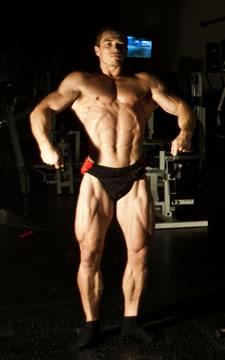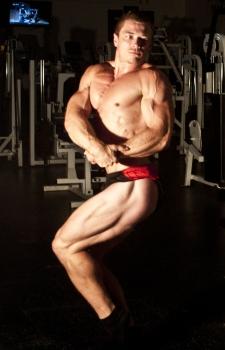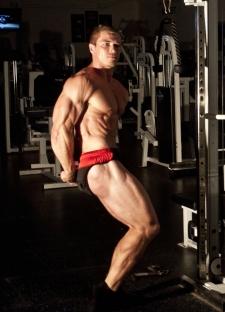Braden Sowle - Natural Bodybuilder Interview
October 19 2011
I know Braden pretty well. Braden has worked for me for almost 4 years now. We always have a lot of interesting conversations about diet and training. Braden’s whole life is all about bodybuilding – he eats, sleeps and drinks bodybuilding. Braden is pretty humble and always willing to help anyone who has questions about their training and diet. Braden is currently working on his M.S in Dietitics.

Age: 25
Competition Weight: 175-185.
Offseason Weight: 205-212.
What is your training program?
It’s hard to describe since it changes so often… a good program is progression based, is dynamic and changing, involves some heavy lifting for dense muscle as well as some higher volume training for that fullness and roundness. I am between competitions right now so I’m just trying to maintain intensity, prevent injury, increase fullness, and most importantly improve conditioning by burning some fat.
What is your diet like?
I eat different everyday depending on my activity levels. But overall I eat a wide variety of foods similar to what our ancestors ate avoiding most pre-packaged and processed foods while focusing on quality sources of meat, veggies, fruits and nuts.
Protein sources: Egg white, whole eggs , turkey, cod (other white fish), salmon, beef(venison or buffalo) whey protein isolate/conc/hydro
Carbohydrate sources: Sweet potatoes, Brown/white rice, oats, sugar free carbohydrate powder
Fats: olive oil, almond, pecan, walnut, peanuts (technically considered a legume)
Fruit: blueberries, raspberries, pear, nectarine, peach, cranberries, apples, lemon, pineapple, plum, etc..
Veggies: Broccoli, Asparagus, Green Beans, Spinach, Romaine lettuce, peppers, onions, mushrooms, bok choy, etc…
Dairy: Greek yogurt
Supplements:
(fat burning) - Caffeine, beta alanine, l-carnatine , green tea.
(strength, power, recovery) - creatine BCAA (recovery), glutamine.
(Increase blood flow) - Arginine.
(Joint lubrication/repair) - glucosamine(w/msm}+chondroitin.
(promote healthy hormone levels) - Vit D, vit E, Zinc fish oil, flax oil.

My eating schedule depends on my activity level, eating more on harder workout days. Each meal has a significant source of protein, and either complex carbs or veggies depending on the timing, I eat most of my carbs in the two meals before my weight training session. On my rest days I eat less carbs and calories.
What do you think are the 3 most important things that people who want to get bigger should focus?
Chips, pizza and ice cream ……but that’s if you want your waistline bigger.
If you want the growth to be muscle mass
1. Design a training split with enough recovery for each body part
2. Be patient, Rome wasn’t built in a day!
3. Don’t make excuses! - Anyone can get bigger you just have to eat more and lift more than you are currently.
Do you think there is a difference in training of natural bodybuilders and bodybuilders on drugs?
Natural athletes need more recovery and I believe in using very low and very high rep ranges to shock the muscle into growth. Most steroid using bodybuilders seem to grow using the traditional 8-12 rep range. Let’s say you dead lifting, rather and doing 3 sets of 10 with 315 or 365, I’d recommends doing something like 495x2, and 405x14…
Do you think bodybuilders should worry about strength like power lifters?
Yes they should try to increase their strength, but not by any mean necessary like power lifters. A bodybuilder who wants to build a bigger chest may try to increase their bench, but if they use their delts and triceps instead of their chest to do the work - the wrong muscles will grow.
What do you think about the low volume and high volume approach of training?
I’ve had success with both types of training; I think rotating between high and low volume programs is best. When I diet for a competition I reduce my volume a bit, but I try to keep my strength and intensity as high as possible.

What are your future goals?
I’m a big believer in short and long term goals. My short term goals include finishing school and earning my pro card as a natural bodybuilder. Long term I want to work with professional athletes as a Strength/Nutrition coach.
What are the 3 biggest mistakes people make in the weight room?
Not training with enough intensity, not emphasizing sleep and nutrition enough, keeping form too strict when it comes to getting bigger, “if you ain’t cheatin’ you ain’t tryin”.
If you have any questions for Braden, ask in the comments please. Thanks Braden and good luck with everything.
Related Articles
| Wed October 19, 2011
“Natural athletes need more recovery and I believe in using very low and very high rep ranges to shock the muscle into growth.”
Good to know what I would refer to low and high reps that do not quite understand: S
and even when I workout muscular failure
| Wed October 19, 2011
Very interesting information about a natural bodybuilder.
I just have only one doubt about ‘too strict forms’. I have been believing in the concept of not encouraging even one counter-productive movement patterns. For example, if we view the saggital aspect of an individual performing Barbell Biceps curls, who after failure will tend to lean back and flex the neck and this posture will resemble ‘SWAY BACK POSTURE’. Can we encourage such cheating (wrong momentum) movements?
| Wed October 19, 2011
Im not sure quite what your asking Bruno, I almost always train to muscular failure and push beyond failure with, forced reps, drop sets, negatives, static holds, rest pause, cheat reps,or partial reps…Most of my of my sets fall within the 6-14 rep range, but occasionally I will do heavier weights for 1-6 reps,or i’ll set my mind on a number of reps go for it, right now I can deadlift 405 for about 10-14, my goal is 20, I also love picking up 5 plates off the floor for a few, can’t wait to be able to pick up 6 plates this offseason!
| Thu October 20, 2011
Vinodh- Everyone may respond different but my biceps really grew once i started curling 135 for 10 reps or so, before that i would be very strict using no more than 75 or 85 lbs, one day I tried 135 and realized if i cheat a little on the way up i can still control the weight down very slow, heavy standing barbel curls for me are all about the negative portion of the lift, now i may do 5 clean reps, 5 cheat reps, 3 partial reps, cheat up 2 more for a slow 5-10 second negative.. after that i’ll rest and drop the weight to say 75 and do 14 or so with strict slow reps with no momentum just to get a pump mostly. Long story short I think curling 135 for 6-14 reps with negatives, partial reps, and cheating will make your arms grow faster than curling 85x10 with strict form with no sway or momentum, its all about extending the set past failure cheating or using momentum is just one way to extend past failure.
| Thu October 20, 2011
Interesting, we see the use of a variety of training techniques to keep training fresh and I think to prevent physiological adaptation. From my experience, constant training to failure on multi-set programs, especially with higher load/low reps, usually leads to early training plateaus due to recovery issues. Some, trainees are blessed with physical properties that can handle this type of training, but I don’t think it works for the majority. If the main training goal is increases in muscle hypertrophy, taking the last set to failure in a multi-set routine using lower load/higher rep with shorter set rests has worked well.
I do like Braden’s goal setting technique. This drive to reach a certain level in training whether it be some form of rep max with a certain load or to complete a certain number of reps with a certain load over a series of sets gives you a target to shoot for. This is a example of progressive resistance training.
As far as “strict form”, we probably all cheat to some degree as we reach near failure. I believe there are studies that demonstrate joint angle changes in exercise as fatigue sets in. The level of “cheating” may of course run into the risk-reward process. You may be training your neurology to adapt to greater loads but actions like hyperextension of the lumbar spine in a closed kinematic chain situation may have higher risks for certain populations
| Thu October 20, 2011
Thanks for you insightfull imput near60lifter, you make many good points, some individualys may be more or less suited for “cheating” depending on the person’s , I belive my lifting roots and personality all play into why i train the way i do, I just plain old like heavy lifting so if i have to cheat a little to lift heavier weight im going to do it as long as i can control it for the negative without injury. I use a balance of cheat/sway form and strict/no momentum form, I have a bit of an anterior pelvic tilt (short/strong lumbar spinal errerctors), i started lifting for american football 10 years back, so my main lifts were powerclean, squat, bench, deadlift so i developed an explosive lifting mentality needed for powercleans. Even if so called “cheat curls” aren’t the best, they are what I enjoy, and what has worked for me, they are a true reflection of my weight training roots (powercleans) and my personality (if i liked lifting light weights, I probly wouldnt sway to power the weight up)... i’ve always had a strong lower back since I can remember, for one reason or another I have cross striations in my lowerback almost year round. I can admit i got a little out of control with barbel curls, over the years i built from 135, to 185, to 225 for a few, then i realized i was pretty much powercleaning 225 up to my chest w/ a reverse grip lol, so i backed off on the weight, now i rarely go over 135 with much more strict form.. cheating/swaying is not for everyone but it may be an effective tool for some to push past failure, if a person isnt suited for cheat curls, partial reps, rest pause, drop sets, static holds, should do the trick to increase intensity, to cause muscle damage, and if you eat/sleep enough you will Grow 😊
| Fri October 21, 2011
Cheating reps needs a lot of practical discussions.
When someone is doing Biceps curls, the shoulder should be actively stabilized by Trapezius. But after reaching failure, people tend to go beyond failure by raising and retracting the shoulder and this kind of mechanism comes under the category of ‘wrong momentum’.
Perhaps when we use the right way of using the momentum while exercising, there will not be any adverse effects on our joint functions, posture and flexibility.
| Fri October 21, 2011
I believe some, like in the curl, use a cheating motion to get the load past the concentric phase where fatigue has reduced ones ability and then control the eccentric phase where there is still existing strength/control.
| Sat October 22, 2011
I have never encouraged my clientele to lift the load by cheating and release the load with good eccentric form. Actually this only made me to ask such questions about the validity of cheating reps. It will be really surprising if individuals performing cheating reps never get joint injuries and unfavorable musculo-skeletal adaptations.
| Sat October 22, 2011
I was just wondering if you lift with a partner? I mean you talk about failure, partial reps, force reps and drop sets, you must have one heck of a good lifting partner. By the way…. good luck today at your show bud….you put the time in you deserve it.
| Mon October 24, 2011
I just want to give a continuation to what I wrote earlier “But after reaching failure, people tend to go beyond failure by raising and retracting the shoulder and this kind of mechanism comes under the category of wrong momentum”. ( you can read this in one of my post above)
In this cheating motions, backward rotation of clavicle takes place. But backward rotation of clavicle is only biomechanically significant during arm elevation beyond 90 degrees.
Anoop | Fri October 28, 2011
I just think a bit of cheating is just fine and just natural. And this is the usual response when someone big post heir routine. We start looking into the trees and miss the forest.
Most bodybuilders will have different training philosophies, but what is common to almost all of them is their passion for lifting, their extreme focus on their diet and goal setting approach. If we have these three, the rest of the variables like reps, cheating. high volume and stuff doesn’t matter too much. I think these three makes the biggest difference.
And we don’t always to make it an either or situation. Pick a barbell curl and do some cheat curls. The next exercise for biceps make it really strict. So you get the benefit of both.
And Braden makes an interesting point about the psychological aspect. Most people who use high volume or low volume or certain approaches do it more so for psychological reasons than physiological reasons.
>










